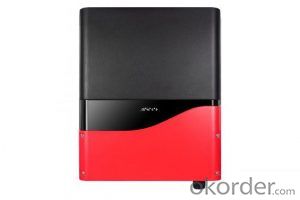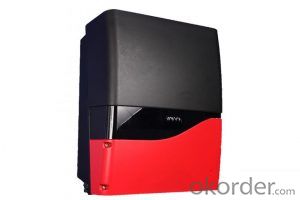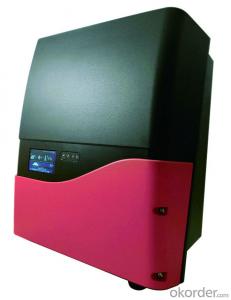Three Phase On-Grid PV-15000T-U
- Loading Port:
- China main port
- Payment Terms:
- TT OR LC
- Min Order Qty:
- 1 pc
- Supply Capability:
- 75000 pc/month
OKorder Service Pledge
Quality Product, Order Online Tracking, Timely Delivery
OKorder Financial Service
Credit Rating, Credit Services, Credit Purchasing
You Might Also Like
Item specifice
Output Power:
15,000W
Inveter Efficiency:
98.1(MAX)
Output Voltage(V):
380
Input Voltage(V):
500
Output Current(A):
24A(MAX)
Output Frequency:
50Hz


Features
VDE-AR-N 4105 & VDE 0126-1-1/A1 & PEA & MEA Certificate
Max & Euro Efficiency:98.3% / 98.1%
Durable & Light Weight Design
Integrated DC Switch, Data Logger, Web Server
RCR ( Ripple Control Receiver, German model )
Ethernet and Optional Wi-Fi
Die-Cast Enclosure
Cloud Web Portal
Optimized for 6” Solar Cell Module
Made In TAIWAN
Item Scale PV-15000T-U Input (DC) MPPT Working Range V 180~980 Max. Current A 20A/10A Max. Short Circuit Current (Isc) A 28A/14A MPP Tracker No. 2 Output (AC) Nominal Power W 15000 Nominal Voltage/ Frequency V 380V/50HZ Max. Current A 24 Efficiency Max. Efficiency % 98.1 General Protection IP65 Humidity % 0~100 Cooling Forced Air-cooling Features Display Icon Graphic Display(Optional) RS485 Standard, Half-duplex Wi-Fi Optional Data Logging Optional Mechanical Dimension(W x H x D) mm 418*485*190 Weight kg 27 Input Pairs 3 DC Switch Optional Certification & Regulation Grid Monitoring VDE 0126/-1-1/A1, VDE-AR-N 4105, AS/NZS 4777.2, AS/NZS 477.3, PEA,NB/T32004 Safety IEC 62109-1, IEC 62109-2 Remarks:
The range of output voltage and frequency may vary depending upon different grid codes.
Specifications are subject to change without advance notice.
- Q:How does a solar inverter handle reactive power injection into the grid?
- A solar inverter handles reactive power injection into the grid by using advanced control algorithms and capacitors. It actively monitors the grid's voltage and frequency and adjusts its output to maintain the required power factor. The inverter can either absorb or inject reactive power into the grid as needed to ensure a stable and balanced power flow.
- Q:Are there any electromagnetic interference concerns associated with solar inverters?
- Yes, there are electromagnetic interference (EMI) concerns associated with solar inverters. Solar inverters convert the direct current (DC) generated by solar panels into alternating current (AC) that can be used to power homes and businesses. During this conversion process, high frequency switching occurs, which can generate EMI. EMI refers to the disturbance caused by electromagnetic radiation from electronic devices, which can interfere with the proper functioning of other electronic devices in close proximity. In the case of solar inverters, the EMI generated can potentially affect nearby electronic equipment, such as radios, televisions, or communication systems. To mitigate these concerns, solar inverter manufacturers often comply with relevant EMI standards and regulations. These may include limits on the amount of electromagnetic radiation emitted by the inverters and the use of shielding materials to reduce EMI. Additionally, some inverters incorporate filters or other EMI suppression techniques to minimize the interference created. It is important for solar installers and system designers to consider EMI concerns when selecting and positioning solar inverters. Proper installation and grounding techniques can help reduce EMI issues. Additionally, local regulations and guidelines should be followed to ensure compliance with EMI standards and to minimize potential interference with other electronic devices. Overall, while there are EMI concerns associated with solar inverters, proper design, installation, and adherence to relevant standards can effectively mitigate these concerns and ensure the smooth operation of both the solar system and other electronic equipment in the vicinity.
- Q:How does the harmonic distortion affect the performance of a solar inverter?
- Harmonic distortion affects the performance of a solar inverter by introducing unwanted frequencies and distortion in the output waveform. This can lead to reduced efficiency, increased power losses, and potential damage to connected electrical devices. It can also cause electromagnetic interference and compatibility issues with the utility grid or other connected systems. Therefore, minimizing harmonic distortion is crucial to ensure optimal performance and reliable operation of a solar inverter.
- Q:What are the advantages of using a three-phase solar inverter?
- There are several advantages to using a three-phase solar inverter. Firstly, three-phase solar inverters allow for higher power output compared to single-phase inverters. This is because they distribute the power across three phases, resulting in increased efficiency and capacity. Additionally, three-phase inverters provide better voltage stability and balance across the three phases of a power grid. This is particularly beneficial in commercial or industrial settings where there may be heavy loads and varying power demands. Furthermore, three-phase solar inverters offer improved reliability and durability. They are designed to handle higher currents and can withstand higher temperatures, ensuring a longer lifespan and reducing maintenance requirements. Lastly, three-phase inverters are more cost-effective in large-scale solar installations. They allow for better utilization of available grid infrastructure, reducing transmission losses and optimizing power distribution. Overall, the advantages of using a three-phase solar inverter include higher power output, improved voltage stability, enhanced reliability, and cost-effectiveness in larger-scale installations.
- Q:Can a solar inverter be used with different types of backup power sources?
- Yes, a solar inverter can be used with different types of backup power sources. Solar inverters are designed to convert the DC power generated by solar panels into AC power that can be used to power household appliances and devices. They can be connected to various backup power sources like batteries, generators, or the grid to provide uninterrupted power supply during periods of low sunlight or power outages.
- Q:How does a solar inverter communicate with other components of a solar power system?
- A solar inverter communicates with other components of a solar power system through various communication protocols such as wired interfaces like RS485 or Ethernet, and wireless technologies like Wi-Fi or Zigbee. These communication channels enable the inverter to exchange data and information with other components such as solar panels, batteries, and monitoring systems. This communication allows for real-time monitoring, control, and coordination of the system, optimizing its performance and ensuring efficient energy production and management.
- Q:What is the role of Maximum Power Point Tracking (MPPT) in a solar inverter?
- The role of Maximum Power Point Tracking (MPPT) in a solar inverter is to optimize the power output from the solar panels by constantly adjusting the voltage and current to ensure that the solar panels are operating at their maximum power point. This allows the solar inverter to efficiently convert the DC power generated by the solar panels into AC power for use in homes or businesses. By tracking and adjusting the maximum power point, MPPT technology maximizes the overall energy production and improves the overall efficiency of the solar inverter system.
- Q:How does a solar inverter provide ground fault protection?
- A solar inverter provides ground fault protection by continuously monitoring the current flow between the solar panels and the electrical grid. If any ground fault or leakage current is detected, the inverter immediately interrupts the circuit to prevent potential electrical shock hazards and damage to the system.
- Q:Can a solar inverter be monitored remotely?
- Yes, a solar inverter can be monitored remotely. With the advancement in technology, many solar inverters are equipped with monitoring systems that allow users to remotely monitor and control their solar power systems. This can be done through various methods such as mobile apps, web-based platforms, or even through specialized software. Remote monitoring enables users to track the performance, energy production, and overall health of their solar inverters from any location with internet access.
- Q:What is the difference between a central inverter and a string inverter?
- A central inverter is a single large inverter that is responsible for converting the DC power generated by multiple solar panels into AC power for use in a building or to be fed back into the grid. On the other hand, a string inverter is a smaller inverter that is connected to a string of solar panels, typically between 6 to 20 panels, and converts the DC power generated by that specific string into AC power. The main difference is that a central inverter is used for larger solar installations, while string inverters are more commonly used in smaller residential or commercial installations.
1. Manufacturer Overview |
|
|---|---|
| Location | |
| Year Established | |
| Annual Output Value | |
| Main Markets | |
| Company Certifications | |
2. Manufacturer Certificates |
|
|---|---|
| a) Certification Name | |
| Range | |
| Reference | |
| Validity Period | |
3. Manufacturer Capability |
|
|---|---|
| a)Trade Capacity | |
| Nearest Port | |
| Export Percentage | |
| No.of Employees in Trade Department | |
| Language Spoken: | |
| b)Factory Information | |
| Factory Size: | |
| No. of Production Lines | |
| Contract Manufacturing | |
| Product Price Range | |
Send your message to us
Three Phase On-Grid PV-15000T-U
- Loading Port:
- China main port
- Payment Terms:
- TT OR LC
- Min Order Qty:
- 1 pc
- Supply Capability:
- 75000 pc/month
OKorder Service Pledge
Quality Product, Order Online Tracking, Timely Delivery
OKorder Financial Service
Credit Rating, Credit Services, Credit Purchasing
Similar products
New products
Hot products
Related keywords





























